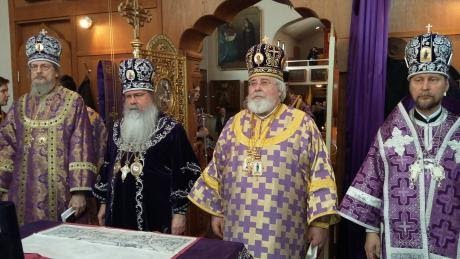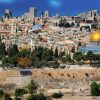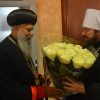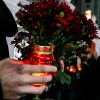At the conclusion of the Liturgy, Metropolitan Tikhon presented an icon and relic of Saint Herman of Alaska. In turn, Archbishop Leo presented an icon of Our Lady of Valaam to Metropolitan Tikhon. The texts of their greetings to one another appear below.
Additional information on and a photo gallery of Metropolitan Tikhon’s visit to the Church in Finland will be forthcoming. [See related story.]
Address of His Beatitude, Metropolitan Tikhon
Church of the Transfiguration of Christ, New Valaam Monastery, Finland
Sunday, February 28, 2016
Your Eminence, Archbishop Leo;
Your Eminence, Archbishop Melchisedek;
Your Grace, Bishop Arseni;
Reverend Father Abbot Sergius and Brothers of this Holy Monastery;
Reverend Fathers, Brothers and Sisters in Christ:
The light of the Transfiguration of Christ, shining brightly in this Holy Church, in this Holy Monastery, and in Your Eminence’s words of greeting, leads us all to joy in Christ – joy in the Holy Eucharist, joy in the fellowship of the Holy Spirit, joy in our common apostolic ministry in Finland and in North America.
It has been a great blessing for me and my small delegation from the Orthodox Church in America to make this pilgrimage to the Finnish lands, to witness the great presence that the Orthodox Church of Finland has established here and to catch a glimpse of the Christian life in all three of your dioceses. We have been ably assisted by bishops, clergy, monastics and faithful of your Church, but most especially by Father Rauno Pietarinen, who has been our faithful guide throughout our visit.
While separated by great distances, the Orthodox Church in Finland and the Orthodox Church in America share a common history and vision. The first saint of America came to Alaska from Valaam. The participation of the late Archbishop Paul of Finland in the 1970 canonization of Saint Herman in Kodiak, Alaska remains a living sign of our common path in mission and sanctity. The abiding presence of the monastic and missionary fruit of Saint Herman and his northern ascetic predecessors was felt very vividly during our visit.
The Orthodox Churches in Finland and North America live in democratic western societies, offering us many opportunities for witness and mission, for pastoral work, for the proper ordering of our Church life. Our churches benefit from structures of shared responsibility of the whole people of God, bishops, priests, and lay people.
Our societies also present us with many challenges. At times, these challenges require of us the courage to be critics of our societies, to be counter-cultural. At other times our societies challenge us to search our faith, our tradition, our conscience to answer difficult questions troubling our nations and our people. At all times, we should strive to speak the truth in love, which can only be done by acquiring the humility of our Lord Jesus Christ.
The Orthodox Churches of Finland and America are united with the Orthodox Churches of Eastern Europe and the Middle East in faithful adherence to the Orthodox Tradition and in confessing the Orthodox Faith. Yet in carrying the western experience within us, our Churches contribute to the wholeness of Orthodoxy today, giving clear evidence that the Orthodox Faith is a living faith, capable of bearing witness in the West as well as in the East. In view of this, it is to be regretted that our Churches have not been able to participate in the preparation of the Great and Holy Synod that will be convened on the island of Crete in June of this year.
Nevertheless, the integrity and authenticity of our Church life is not dependent on status or recognition. What matters is the quality of our mission and witness. As the Orthodox Church of Finland and the Orthodox Church in America strive to “increase the measure of grace committed to us,” seeking to be faithful to the Gospel in all dimensions of ministry, we can, and must, strengthen and support one another. This mutual support and encouragement should be expressed in co-operation and collaboration. Your Eminence has identified three dimensions of desirable collaboration and exchange. We join you in this vision.
Seminary exchange programs are an excellent starting point. Our young people – and through them our Churches – would benefit from direct experience of one another’s seminaries and parishes, from growing knowledge of one another’s Church institutions and ministries.
The North American societies of the United States and Canada and the Finnish society present questions and challenges to human existence which our Churches are not fully prepared to address. A dialogue in the field of ethics would enhance our ability to discuss difficult issues and would help equip our Churches to take up these difficult issues responsibly, honestly, and competently.
Finally, the United States and Canada, together with Finland and other Nordic countries, have important connections to the Northern or Arctic region. We affirm the need to strengthen the cooperation of our Northern areas – Finnish Lapland and the Oulu Diocese in Finland, Alaska, and parts of Canada. We share a common concern for our indigenous people in the North.
Without delay let us set up a joint mechanism to initiate and encourage collaboration in these areas, and to remain alert for other areas of collaboration which will emerge.
We look to Your Eminence as Archbishop of the Church of Finland to be our partner in this common work and this common vision. Your visits to our Church have been milestones of the good relations between our Churches. Your messages to our Church, most recently your greeting to our All-American Council in Atlanta, were inspiring and visionary words on the mission of the Orthodox Church in America, a mission transcending ethnic boundaries and lifting up the light of Christ for all to see.
Some years ago Patriarch Ignatius of Antioch reflected on the Orthodox way through history, pointing out the strong Orthodox tendency to turn our attention to the past. He criticized this default tendency, insisting that if we are following the Risen Christ, we are following Him into the future, and not into the past. The Christ of the Transfiguration introduces us to the Christ of the Resurrection. Our response to the Transfiguration and the Resurrection is a response of joy. Let us walk together with joy as we follow the Risen Christ into the future.
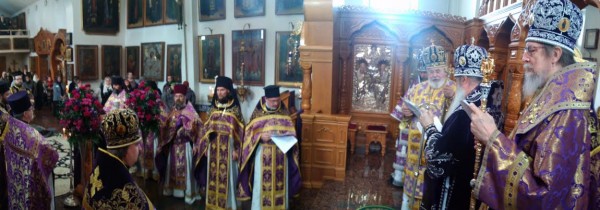
Photo: http://oca.org/
Address of His Eminence, Archbishop Leo
Church of the Transfiguration of Christ, New Valaam Monastery, Finland
Sunday, February 28, 2016
Your Beatitude, Your Eminence, Reverend Fathers, sisters and brothers:
I wish to express my warmest thanks to Your Beatitude and your delegation for accepting our invitation of last summer to visit the Orthodox Church in Finland. By now you have all been to both the Helsinki and Oulu dioceses, and now you come to our Archdiocese. In this Valaam Monastery of the Transfiguration of Christ we say, as did Saint Peter on Mount Tabor, “it is good for us to be here” [Luke 9,33].
The Orthodox Church in America and the Orthodox Church in Finland have a long common history. The late, venerable Archbishop Paul was present at the canonization of Saint Herman in Alaska in August 1970. When this church where we are now was consecrated in the summer 1974, Bishop Theodosius, who eventually served as your Metropolitan, concelebrated with our Archbishop Paul. A delegation of the Orthodox Church in Finland, under my leadership, paid a visit to Your Church and particularly to Alaska ten years ago in 2005. Your Beatitude as a young bishop was part of the group of our hosts in Alaska.
An important bond between our Churches has been Saint Vladimir’s Orthodox Theological Seminary, where several young Finns have studied over the years. We wish to mention the special gift of the Orthodox Church in America to the whole Orthodox world, and other Christians as well, in the form of books by the ever-memorable Fathers Alexander Schmemann, John Meyendorff (whose son Professor Paul Meyendorff is also here present) and Thomas Hopko. May their memories be eternal!
Our Churches are similar in many ways. We both function in Western societies. Our administrative systems are transparent. Laity has an active role in Church administration on all levels. Both Churches are ecumenically active and are separated from State structures.
The Great and Holy Synod, which is of enormous importance to all Orthodox Churches, is planned to be held in the Orthodox Academy of Crete this coming June. The Orthodox Church in Finland has not been able to participate in its preparations for several years now because only Autocephalous Churches have been invited. The Orthodox Church in America, however, has not been able to participate in the preparatory process, because your autocephaly has not received universal recognition. We are aware of the report to the Synod concerning the concept of autonomy. But the question of autocephaly seems to be postponed. We hope that the autocephaly of the Orthodox Church in America will soon receive universal recognition, because the existence of a local Orthodox Church should always be based on the territorial principle, not an ethnic one. Numerous Orthodox dioceses based on the ethnic principle – as indicated by their very names – severely weaken the Orthodox mission and witness.
Your Beatitude! Let us consider some forms of future cooperation for our Churches.
As we mentioned earlier, several Finnish students have studied at Saint Vladimir’s Seminary in New York. The last years have been quite quiet. Now we need to find talented youths who could study at your seminaries, and those who could come from the Orthodox Church in America to Joensuu for a couple of months to learn about life of our Church, or to study at the University through existing international student exchange programs.
Since our Churches function in rather similar cultures and conditions, we consider it important to have a dialogue in the field of Orthodox ethics. Topics which are now relevant include an understanding of the family, respect of life both in its early and late phases, and questions of bioethics. In Finland our Church has the opportunity to live in close connection with society. This is rather helpful for proclaiming the Orthodox faith. This situation also raises new questions. We need fresh perspectives stemming from genuine Orthodox thinking to answer these new questions.
As a third prospect we mention the Northern, so called Arctic region, of which Finland is also a part. Unfortunately Your Beatitude was not able to visit the furthest North this time. But, I trust that the next OCA delegation will see Finnish Lapland. Alaska, certain areas in Canada and the Oulu Diocese in Finland, will be very important in the future. Climate change makes its biggest changes in the Arctic, where people are the least responsible for the changes. The indigenous people living in these areas are important to our Churches. It is also good to remember, that the most significant monasteries of Old Russia emerged in the Northern region. The severe nature (of the North) contributed to the ascetic life of many saints, such as Herman, Juvenaly, Peter, Innocent and Jacob of Alaska; Sergius and Herman of Valaam; Arseni of Konevets; Alexander of Svir; Trifon of Petsenga; Herman, Zosima and Savvati of Solovetsk; Cyril of Beloozero; and many others. Powered by their holy prayers, we need to strengthen our cooperation in our Northern areas.
Finally, let us return to Mount Tabor. A guarantee of the unity of Local Orthodox Churches is the Divine Liturgy, the one Eucharist. The Orthodox Church in America is in Eucharistic communion with the rest of the Orthodox Churches. Thus we also could be taken to Mount Tabor today to celebrate this heavenly sacrament. And even though it would be good to be there, we need to return to the world. It is our task to return to the world and bring light to darkness—that light which this world cannot give. Only this light may enlighten even the darkness of hell. This is our task: to serve, not to be served.
As You, Your Beatitude, will soon be returning home to serve, I am convinced that we here in Finland will have the same experience as did the disciples on the way to Emmaus. We shall also say: Were not our hearts burning when our brothers in Christ were with us? Were not our hearts burning when we stood together before the heavenly altar celebrating this service of sacrifice ”for the life of the world?” May our faith in Christ ever warm our hearts, our two Churches of the North.












